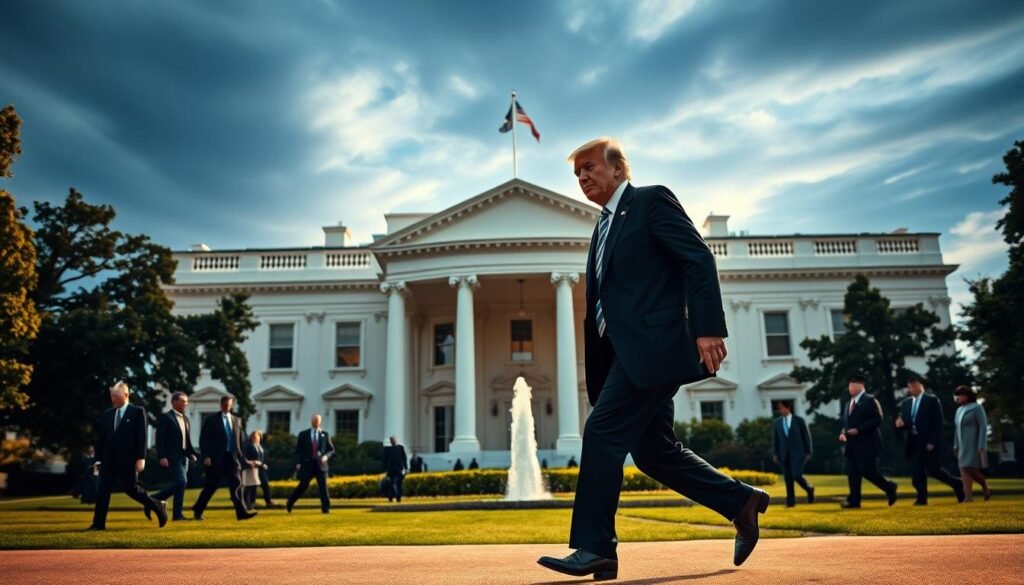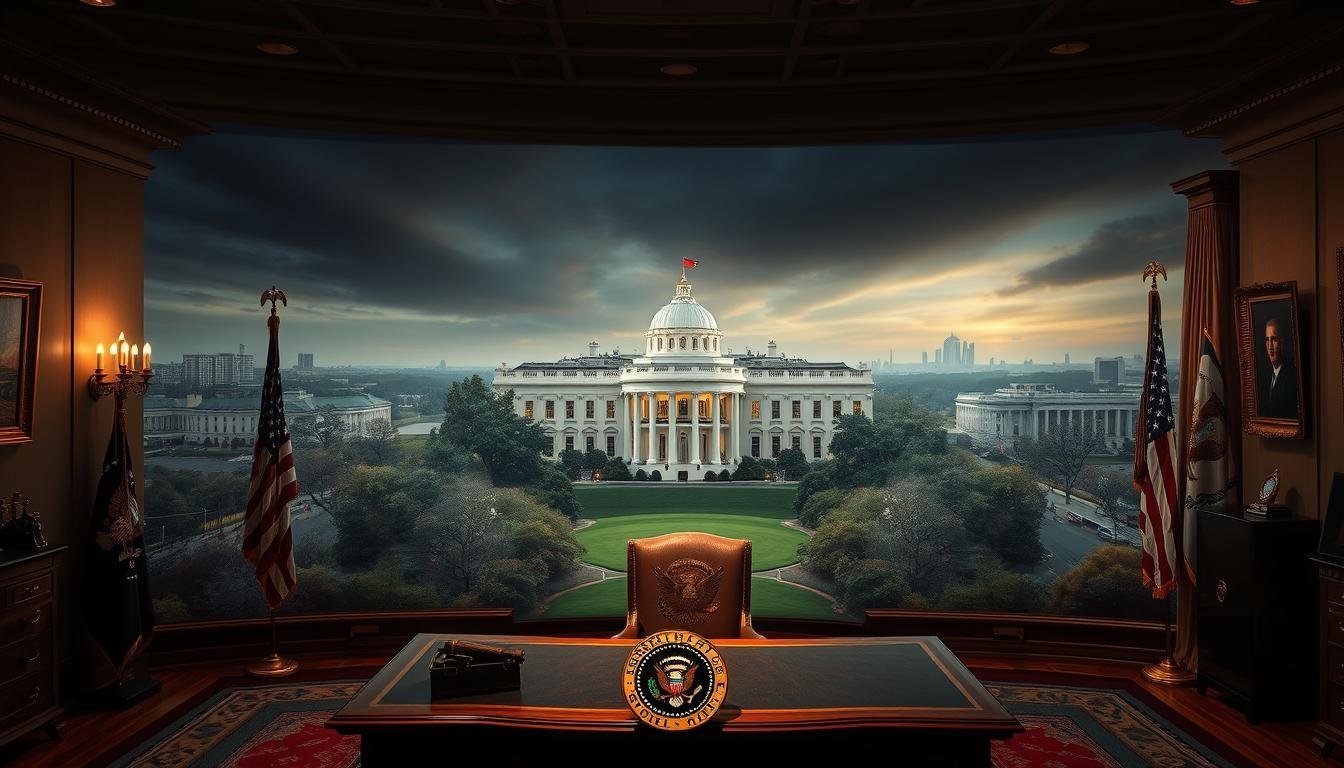Can the President Fire Government Employees? Have you ever thought about presidential powers when it comes to hiring and firing government employees? The relationship between the executive branch and federal workers is complex. It’s governed by laws and regulations that balance the President’s authority with employee rights.
It’s important to know your rights and the limits of presidential powers. The question of whether the President can fire government employees is key. It involves job security, due process, and the rule of law.
This article will dive into the details of government employee rights and the President’s authority. We aim to provide clarity on this critical issue.
Contents
- 1 Presidential Authority Over the Executive Branch
- 2 The Civil Service System and Its Protections
- 3 Categories of Government Employees and Their Protections
- 4 Historical Cases of Presidential Firings
- 5 Can the President Fire Government Employees? Legal Framework and Limitations
- 6 Conclusion: Can the President Fire Government Employees?
- 7 FAQ
- 7.1 Can the President fire a government employee without cause?
- 7.2 What is the Civil Service System, and how does it protect government employees?
- 7.3 Are all government employees protected by the Civil Service System?
- 7.4 Can the President fire government employees who are part of an independent agency?
- 7.5 How do landmark Supreme Court cases impact the President’s ability to fire government employees?
- 7.6 What are the implications of the President’s ability to fire government employees for the executive branch?
Presidential Authority Over the Executive Branch
To understand the president’s power, we need to look at the Constitution and laws. The Constitution, specifically Article II, makes the president the head of the executive branch. It gives them the power to appoint and remove officials, shaping the branch’s direction.
The president’s presidential powers go beyond the Constitution. Laws also define their authority. For example, laws let the president reorganize agencies and make important personnel choices.
The president’s power over the executive branch affects government workers. They have a lot of say in who gets hired or fired at the top levels. But, the rules for removing civil servants are more complicated. Knowing these details helps us understand the president’s full impact on the branch.
In short, the president’s power comes from the Constitution and laws. This power greatly influences the executive branch and the careers of its employees.
The Civil Service System and Its Protections
It’s important to know about the civil service system to understand its limits on the president’s power. This system was set up in the late 1800s. It aimed to make the federal workforce more professional by moving away from the spoils system. This old system gave jobs based on who you knew, not your skills.
The Pendleton Civil Service Act of 1883 was a big step forward. It made hiring and promoting government workers based on exams, not politics. This change helped make jobs more about who was best for the job, not who knew the right people.
Today, government workers are sorted into different groups based on their jobs. This sorting is key to knowing how much protection they get. Some jobs offer more protection than others.
Civil service laws protect government workers from being fired unfairly. These laws say that firing someone must be for a good reason, like bad performance. Workers also get a chance to defend themselves before being let go.
Key Protections Under Civil Service Laws
| Protection | Description |
|---|---|
| Due Process | Employees are entitled to a fair hearing and an opportunity to respond to allegations before any disciplinary action is taken. |
| Merit-Based Decisions | Employment decisions, including promotions and terminations, are based on merit rather than political considerations. |
| Protection Against Retaliation | Employees are protected from retaliation for whistleblowing or participating in investigations. |
These protections make sure government workers are treated right. They help keep the federal workforce stable and professional. By limiting the president’s power to fire workers, the civil service system keeps government running smoothly and fairly.
Categories of Government Employees and Their Protections
Government employees are not all the same. They are grouped by their job status and the protections they get. Knowing these groups helps us understand federal employee protections and government employee rights better.
There are many types of government employees. These include permanent workers, temporary workers, and political appointees. Each group has its own set of protections and job security rules.
Permanent employees, for example, are covered by the Civil Service Reform Act of 1978. This law gives them certain rights and protects them from unfair labor practices. They are split into two groups: competitive service and excepted service.
Competitive Service vs. Excepted Service
Competitive service employees are hired through a fair process. This means they pass exams and are chosen based on their skills. Excepted service employees, however, are not chosen this way. They often have jobs that are policy-related or need special skills.
| Category | Employment Status | Protections |
|---|---|---|
| Permanent Employees | Career Civil Service | Civil Service Reform Act Protections |
| Temporary Employees | Term or Temporary Appointment | Limited Protections, often at-will |
| Political Appointees | Serve at the Pleasure of the President | Minimal Protections, often at-will |
Temporary employees and political appointees have different job security levels. Temporary workers have fewer protections and can lose their jobs more easily. Political appointees can be removed by the president without many protections, unlike permanent employees.
It’s important to know these differences to understand federal employee protections and government employee rights. When dealing with government jobs, knowing the different categories and their protections helps clarify job security and rights for various employees.
See Also: What Are the 5 Requirements to Be President?
Historical Cases of Presidential Firings
Looking into the history of presidential firings shows us many factors at play. Politics and policy disagreements are big ones. The power to fire employees is a key part of a president’s job, with many examples showing how it’s used.
One example is when President Warren G. Harding fired Attorney General James McCumber in 1921. This showed the tension between political appointees and career civil servants. Later, President Donald Trump fired several top officials, including FBI Director James Comey. This move sparked a lot of debate about presidential powers.

These examples show the complex relationship between presidential powers and the executive branch. Below is a table with some key cases of presidential firings:
| President | Official Fired | Reason |
|---|---|---|
| Warren G. Harding | James McCumber | Policy disagreements |
| Donald Trump | James Comey | Investigative controversy |
| Theodore Roosevelt | Various officials | Administrative reforms |
These cases highlight the big role presidential firings have in shaping the executive branch. Knowing about these cases helps us understand the legal and political sides of a president’s power over employees.
Can the President Fire Government Employees? Legal Framework and Limitations
The president’s power to fire government employees is limited by laws. These laws have been shaped by important Supreme Court decisions. Understanding these laws helps us see how much power the president really has.
The civil service laws are key to federal employee protections. They limit the president’s ability to fire employees without reason. The Supreme Court has helped shape these laws over time.
Myers v. United States (1926)
In Myers v. United States, the Supreme Court said the president can remove some officials without Senate approval. This set a big precedent for the president’s firing power.
Humphrey’s Executor v. United States (1935)
But, the Court later said the president can’t fire certain officials, like those on independent commissions, without a good reason. This added a key detail to the president’s authority.
In Morrison v. Olson, the Court made it clear that the president can’t remove the independent counsel easily. This decision helped protect federal employees.
Seila Law LLC v. Consumer Financial Protection Bureau (2020)
The Court’s decision in Seila Law LLC v. Consumer Financial Protection Bureau said the Consumer Financial Protection Bureau’s structure is not fair. This ruling has big implications for understanding who can be fired in government.
| Case | Year | Ruling |
|---|---|---|
| Myers v. United States | 1926 | President has authority to remove executive branch officials without Senate approval. |
| Humphrey’s Executor v. United States | 1935 | President cannot remove officials from independent regulatory commissions without cause. |
| Morrison v. Olson | 1988 | Upholds constitutionality of Independent Counsel statute. |
| Seila Law LLC v. Consumer Financial Protection Bureau | 2020 | CFPB’s single director structure deemed unconstitutional. |
These cases together show the legal limits on the president’s power to fire employees. They highlight the complex legal framework for government employee termination. The Supreme Court has been key in shaping this framework.
Conclusion: Can the President Fire Government Employees?
You now understand the complex relationship between the president’s power and government employee rights. There are many laws that limit the president’s actions. This balance is key to fair government work.
The Civil Service System helps protect employees from unfair firing. Some jobs have even more protection. Past cases show the president’s power, but also the importance of following the law.
Understanding the mix of presidential power and employee rights is vital. It keeps the government fair and protects workers. This balance is essential for a healthy government.
See Also: Did Any U.S. Presidents Have Wooden Teeth?
FAQ
Can the President fire a government employee without cause?
The President can’t fire anyone without reason, thanks to the Civil Service System and laws. The President has a lot of power, but some employees are safe from unfair firing. They can only be let go for certain reasons.
What is the Civil Service System, and how does it protect government employees?
The Civil Service System is based on merit, guiding who gets hired and fired. It makes sure employees are treated fairly and without bias. This system limits the President’s power to fire employees without cause.
Are all government employees protected by the Civil Service System?
No, not everyone is covered. Some, like those in the Senior Executive Service or at the President’s pleasure, might not have the same protections.
Can the President fire government employees who are part of an independent agency?
The President’s power to fire employees in independent agencies is restricted by law. Cases like Humphrey’s Executor v. United States (1935) and Seila Law LLC v. Consumer Financial Protection Bureau (2020) show that some can only be fired for cause.
How do landmark Supreme Court cases impact the President’s ability to fire government employees?
Important Supreme Court decisions have shaped the rules for firing government workers. Cases like Myers v. United States (1926) and Seila Law LLC v. Consumer Financial Protection Bureau (2020) have set key limits on the President’s power.
What are the implications of the President’s ability to fire government employees for the executive branch?
The President’s firing power affects the executive branch’s ability to carry out its policies. But, limits on this power protect employees from unfair dismissal. This lets them do their jobs without fear of being fired unfairly.

Hi, I am Tatum Bradford from Washington. I have a background in political science and work as a senior revenue officer. I love learning about U.S. presidents and sharing interesting facts about political history.

